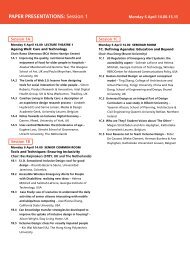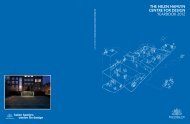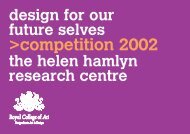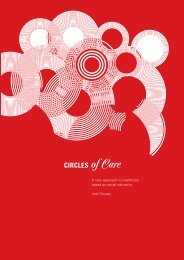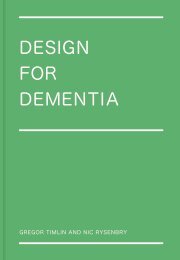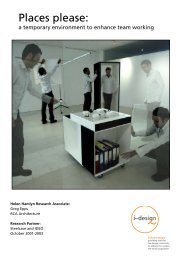Design for Dementia - Helen Hamlyn Centre - Royal College of Art
Design for Dementia - Helen Hamlyn Centre - Royal College of Art
Design for Dementia - Helen Hamlyn Centre - Royal College of Art
Create successful ePaper yourself
Turn your PDF publications into a flip-book with our unique Google optimized e-Paper software.
DESIGN FOR DEMENTIA<br />
CONTEXT<br />
Research Methods<br />
A major challenge <strong>for</strong> this study was to create research methods that were<br />
appropriate <strong>for</strong> people with dementia. These had to be sensitive to their needs<br />
and respectful <strong>of</strong> them as individuals. Conducting ethnographic research with<br />
any group deemed to be vulnerable can be difficult, but working with people<br />
with dementia is particularly challenging as the mental condition <strong>of</strong> the person<br />
participating in the research is affected.<br />
Two ideas became important. Firstly to find ways to engage with residents<br />
with dementia and allow them to express themselves and their opinions. Secondly,<br />
to see them not as test subjects <strong>for</strong> research but as real people with real lives.<br />
The research methods draw on processes already established within people<br />
centred design, but one tailored to the care home environment and the effects <strong>of</strong><br />
dementia. The goal was to gather and collate existing knowledge in the field, cross<br />
reference this with findings from research with users and translate the results<br />
into design criteria and solutions <strong>for</strong> dining room and bedroom design.<br />
Central to the study has been the participation <strong>of</strong> people with dementia in<br />
the research. Care home residents with dementia are the real experts on what they<br />
want and expect and as the people who are actually living through the experience,<br />
they are best placed to provide critical insight into what can be improved.<br />
Research was completed in three stages:<br />
1.<br />
Creating a basic understanding <strong>of</strong> dementia and its effects on older<br />
people in care. Beginning with desk research such as literature<br />
reviews <strong>of</strong> care practice, seminars on topics related to the research,<br />
including the UK dementia congress were attended, as were<br />
induction sessions <strong>for</strong> new staff in care homes to experience the<br />
training programme firsthand. Two focus groups involving 14 people<br />
in the early and mid stages <strong>of</strong> dementia outlined key concerns<br />
and failings, as well as opportunities <strong>for</strong> further investigation.<br />
UNDERSTANDING<br />
DEMENTIA<br />
ESTABLISHING<br />
DESIGN CHALLENGES<br />
Literature review<br />
and audit <strong>of</strong> good<br />
and bad practice<br />
Visits to existing<br />
care homes<br />
Focus groups<br />
involving people<br />
with dementia<br />
Interviews with<br />
residents, staff and<br />
family members<br />
2.<br />
3.<br />
Establishing the current challenges faced by both residents and<br />
care workers in UK care homes. 18 day visits to care facilities took<br />
place in environments ranging from family homes to larger, long<br />
stay care institutions. A variety <strong>of</strong> techniques were used to gather<br />
insights including observation, photographic ethnography and<br />
in<strong>for</strong>mal interviews with residents and staff. This enabled a range<br />
<strong>of</strong> data to be captured. Observation allowed events to unfold and<br />
be recorded in a natural, everyday setting with no interference<br />
from the investigators, and interviews gave a more in-depth view<br />
<strong>of</strong> particular issues.<br />
Development and testing <strong>of</strong> design concepts. Once insights were<br />
gathered and organised into design briefs, various concepts were<br />
developed and tested. The most promising ideas were taken <strong>for</strong>ward<br />
as physical models and then finalised as exemplar designs.<br />
–<br />
Opposite:<br />
breakdown<br />
<strong>of</strong> the<br />
research<br />
methods<br />
and design<br />
process<br />
DESIGN OUTCOMES<br />
Development <strong>of</strong><br />
design briefs and<br />
concepts<br />
Production <strong>of</strong><br />
exemplar designs,<br />
prototypes and<br />
publication<br />
26<br />
27



